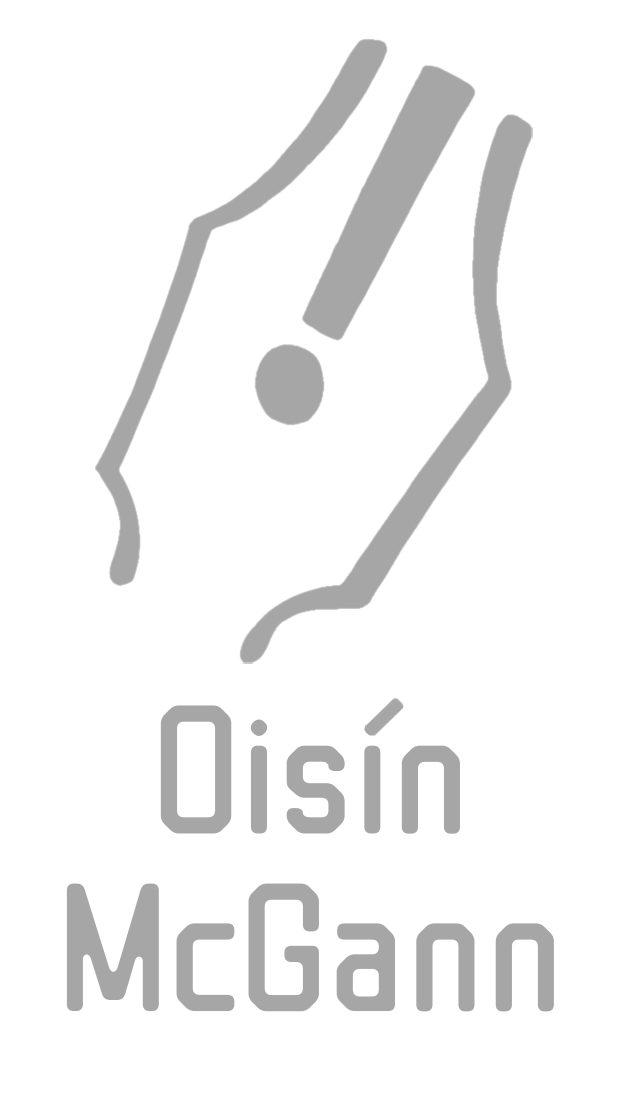I wanted to talk about this, not just because the making of this book has been an interesting process, but also because it gives some insight into the growing overlap between traditional and self-publishing. Publishing books is an uncertain business for all but the tiniest proportion of authors, but the story of this particular book covers a period where the environment for mid-list authors has become particularly chaotic.
By ‘mid-list’, I mean anyone who’s had enough success to keep publishing, even if they’re not making a full-time living from it – which itself is becoming an uncertain metric. As the world seems to be edging towards the extremes in so many areas, traditional publishing is following a similar pattern, with the marketing and subsequent bulk of the sales being driven by an ever-decreasing number of authors.
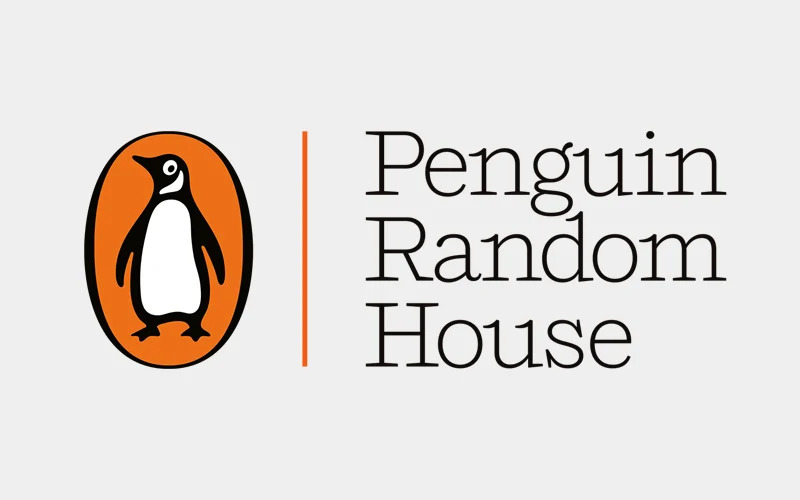
Some Background
This story starts in 2013, with the merging of two giants of our industry, Penguin and Random House, to form . . . Penguin Random House, in defiance of everyone daring them to call it ‘Random Penguin’.
At the time of the merger, I was being published by both companies. My surveillance state thriller, Rat Runners, had been released by Random House in 2013 and I’d been commissioned by Penguin to write two origin books based on the online medieval fantasy game, Kings of the Realm, entitled War’s Harvest and Cruel Salvation. This was while Penguin was still operating separately in 2014. That job came about because one of the editors I’d worked with at Random had got in touch after she moved to a senior position in Penguin.
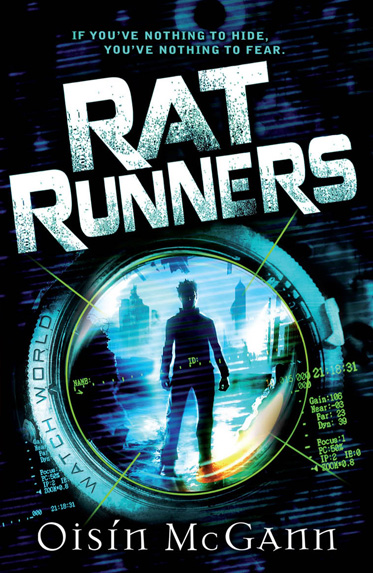
I knew I was on thin ice with Random. I’d had big advances for my first four books with them and they hadn’t earned out, though that had been where I’d first learned that getting a big advance didn’t necessarily mean that you’d get the marketing budget to back it up. Even at that level, an author is often expected to do most of the marketing and publicity for their books – and I didn’t live in the UK, so every trip over was that much more expensive. The deal for Rat Runners was a good bit smaller, and though the book got some excellent reviews, the marketing push reflected the smaller advance. The initial reactions to it were so good though, that I wrote a sequel. Months later, with the merger crunching down, I found out that Random weren’t interested in the sequel, about 10% of the staff in their children’s department was being let go and it looked like they were quietly dropping a load of their authors too.
Meanwhile, over at Penguin, the Kings of the Realm books were very much tied into the fate of the game – to the point where they were only released as ebooks in the UK. That job was a whole story in itself that I won’t go into here, but the first book was published in paperback in France and Germany so, weirdly, the only print editions I have of it are in languages I can’t read. There was also a solid offer from a Brazilian publisher that fell through, though I was never told why. Like Rat Runners, the game got off to a good start, it was well received, but never really made a big splash. Where it went, the books went with it.
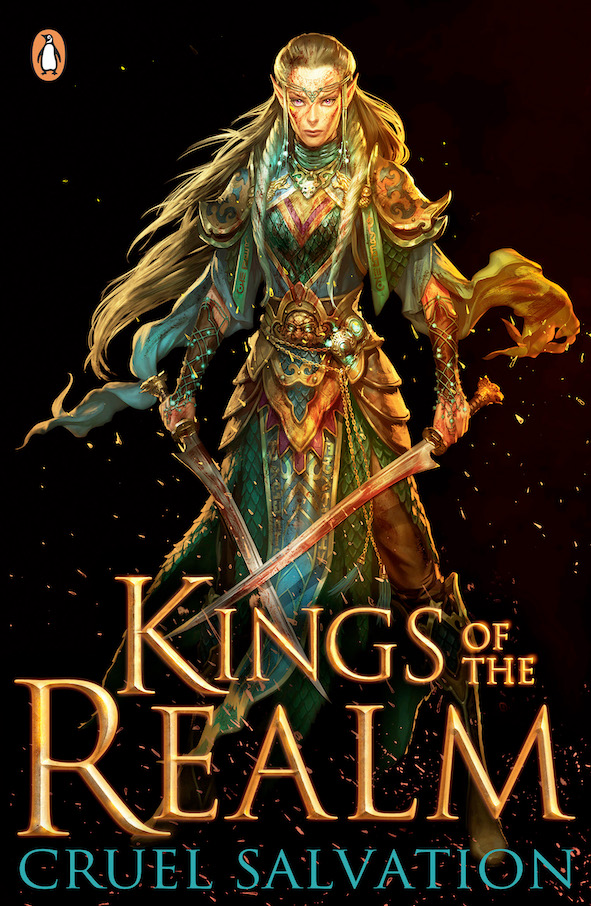
The editor at Penguin still liked my work however, and she wanted to give me another chance, so we met up in Dublin and after some back and forth, she asked me to pitch her a young adult science fiction story set during a famine. I was uncomfortable setting a sci-fi story during Ireland’s Great Famine and I didn’t want something very drawn out, so I wrote the pitch for a story about a small community on an island that’s plunged into a crisis over a short period of time, and how the rules that governed their communication made things worse. That was where the early concept for Cut Off at the Throat came from, though at the time it was entitled The Less Sed, and had a kind of Clockwork Orange-style, text-speak narration. I ironed that out and renamed the story Tip of the Tongue.
Closing Doors
In the end, she didn’t take it, but I felt it was worth finishing the book and pitching it to other publishers. One rejection does not a failure make and this book wanted out. One thing I always do when coming up with titles is search for them online, to avoid using something that’s been used loads of times before. It also helps to turn up other issues early . . . like the kinds of websites you find when you search for ‘Tip of the Tongue’ online. So I changed the title again, this time to Pass by Mouth, trying to capture the two key themes in the story; hunger and communication. And I finished the book.
Then I took another blow. My agent, who at that time I’d been with more than ten years, just point blank refused to pitch it. It was the first time she’d ever done this with a book, it hit me pretty hard and we actually never ended up having a proper conversation about why, though I presume it was down to the reason this group of teenagers were on the island, which was pretty dark (I’m not telling you, because spoilers), but it certainly wasn’t as grim as the premise of, say, The Hunger Games for instance. At this point, I’d been publishing steadily for twelve years, so I was confident of judging whether a book was marketable or not, but this one demanded a publisher with a decent track record in science fiction. I did end up pitching it to two publishers myself, with no luck, but in the UK, if your agent doesn’t pitch it, she’s basically rejecting it on behalf of the entire UK publishing industry. So in the end, I shelved the book and figured the opportunity to do something with it would come up eventually. And so it sat there . . . waiting . . .
A New Environment
Now it’s 2024. I’ve had forty-six books published in different forms, including twelve novels, I’ve illustrated more than that again, and the publishing environment is still changing. I’ll actually have to do a blog some day on all the different ways I’ve been published (including in a previous career as an advertising copywriter), but it’d be hard to know where to start with that.
Anyway, I’ve been saying for years that the pressure on traditionally published authors to do most of the work themselves will reach the point where it’ll start overlapping with self-publishing. So in June this year, I figured it was time to put my money (or my work, at least), where my mouth is. I mean, as well as being a writer, I’m an illustrator and designer – I can produce every element of a book, so why the hell not, right?
There was a time when self-publishing meant going to what was once referred to as a ‘vanity publisher’, and it tended to be looked down on by the mainstream, because the condition of entry was money, not quality. You were seen to be bigging yourself up, instead of submitting to the judgement of the industry. Even so, some very successful, famous and critically acclaimed authors started off as self-published, including Margaret Atwood, Beatrix Potter, Andy Weir, Jane Austen and Roddy Doyle. And the publishing industry has been changing the whole time.
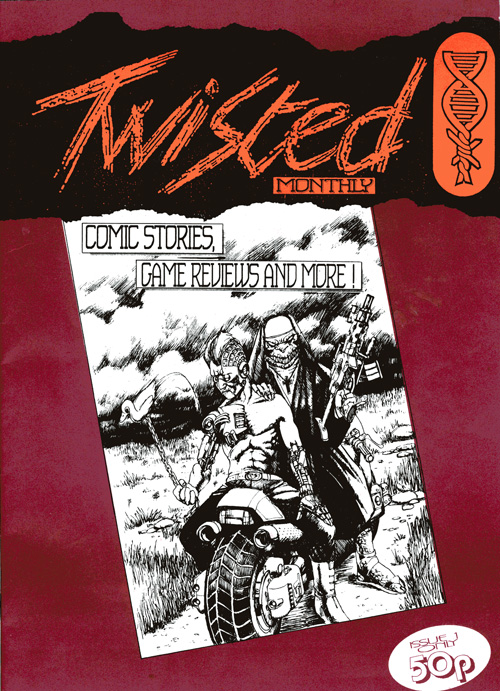
I’ve self-published before. The first time was way back in the olden days in 1993, ten years before I published my first books as an author, long before ebooks, before even the worldwide web was really a thing. It was a comic called Twisted that I got printed; black and white with a three-cover colour no less, for which I had to do the colour separations. It had the first episodes of four stories and I did all of the writing and illustration work myself. The comic included some games and anime reviews because I put it together with the help of some guys I knew in a games shop. I even managed to sell a couple of ads to help cover the cost. I’d started looking for collaborators, but I didn’t end up doing another issue because at that point, I just didn’t know enough about distribution and marketing and the freelance illustration work had started picking up.
Then in 2009, having set off on my career as an author, I released the novella, The Vile Desire to Scream free online – though only on my website – to promote The Wildenstern Saga, my Irish steampunk books. With the assistance of my ever-helpful brother Marek, I released it as a PDF, an epub and Kindle’s MOBI file. There was some decent pick-up on it, and interestingly, the PDF did much better than the ebook files back then.
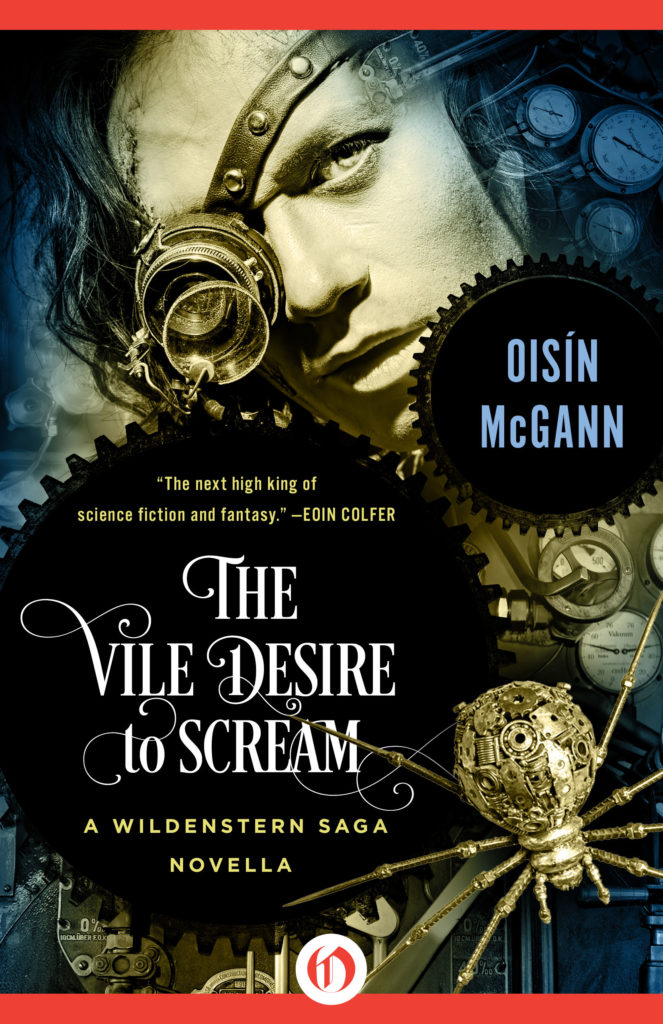
For anyone who doesn’t know, the PDF format was designed to show how something will look when it prints. The whole point is that the text and formatting don’t budge, so it’s a good way of seeing what you’re going to get. It’s the standard means of proofing in publishing now, avoiding the need for printed proofs, but for an ebook, this rigidity makes the text awkward to read on small screens. An epub or similar ebook file works the opposite way; it’s designed more like a web page, to change the format of the text to fit whatever window you’re using to read it. My guess is that, in 2009, a lot of people still wanted to read ebooks on their laptops, where a PDF can still be a comfortable fit and it was a more familiar format. The novella got enough interest that when Open Road Media released a bunch of my books in the US, I did two more novellas, The Need for Fear and Spoil the Kill, and Open Road published all three alongside the novels as part of the marketing for them.
Take note, because these will become relevant again later.
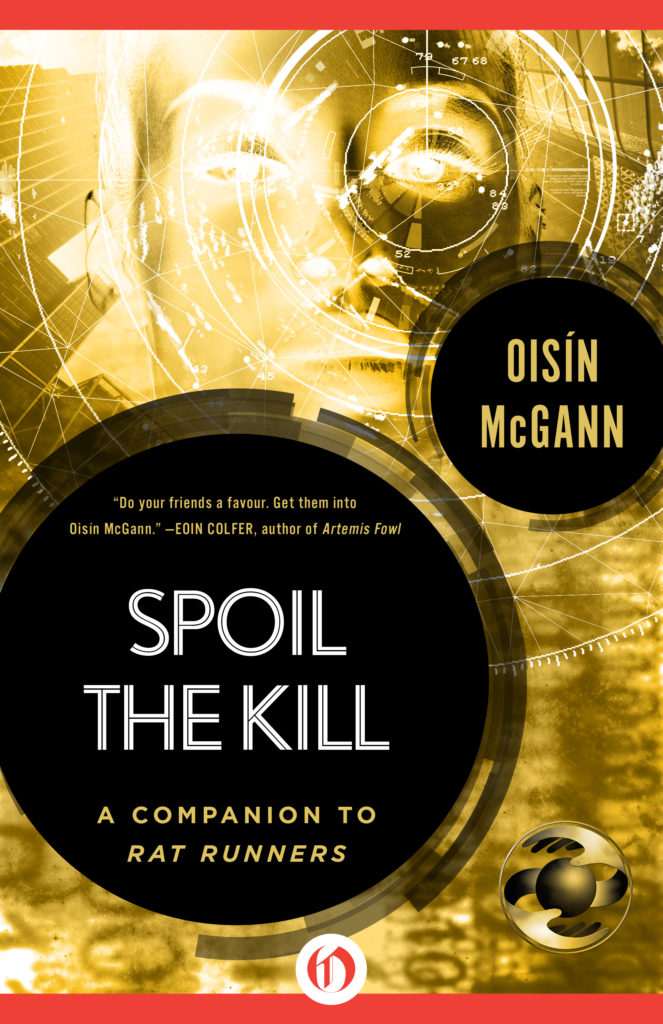
But the self-publishing environment has changed completely in the last ten years, what with the proliferation of online publishing platforms, print-on-demand (the ability to order one book to be printed at at time), a ballooning indie publishing scene, Amazon’s Kindle Direct Publishing, fan fiction, and elements like keywords and subtitles to consider to optimize searches, along with categories within categories within categories. And in a fine piece of irony, the Evil Empire now offers the best options for self-publishing, the greatest potential reach and the *biggest cut for authors* (publishers take note). So yes, I’m starting with Amazon. I can feel my soul wither as I write this, but I’m professional writer, so my soul has withered plenty already.
Anyway, I wanted to try a narrative device I haven’t seen used anywhere before, I wanted to do some dark, slightly head-melting sci-fi and I’ve never actually illustrated the cover for one of my novels.
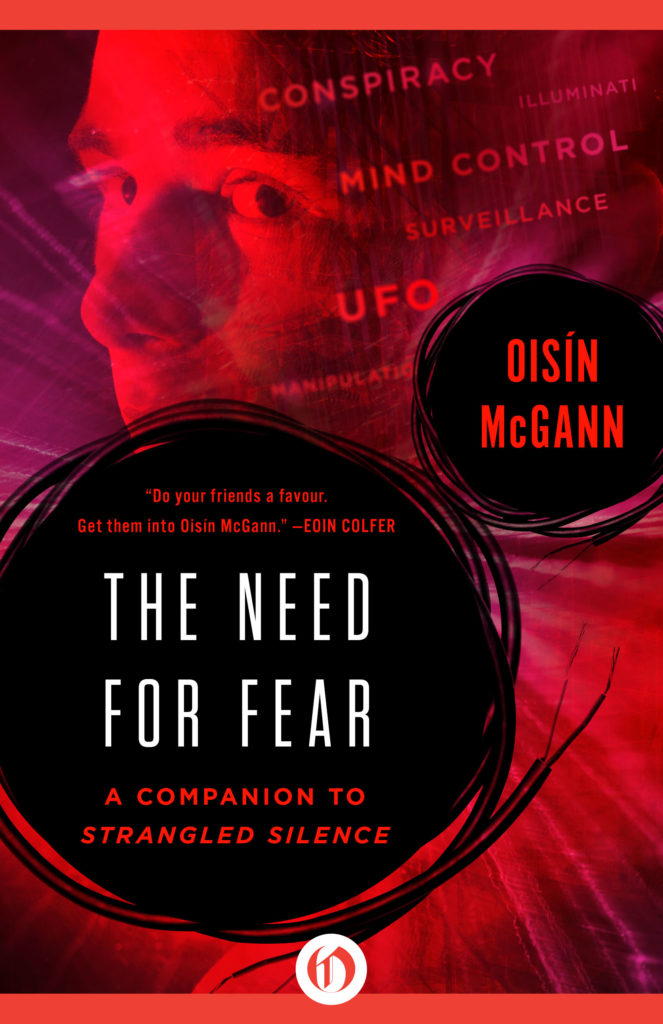
It was time to make a book.
Creating the ebook was going to be easier, so I started with that. An ebook works like a website rather than something you’re printing, and I tried two different ways. Calibre is a well-known app that can create different kinds of ebook files, but editing text in it is clunky, and once I’d decided to start with Amazon, it made sense to use their app, Kindle Create. As it turned out, it worked a lot better. The problem with novel text is that you always think you’re finished until you spot the next mistake. And if you spot the mistake as you’re proof-reading your ebook, you need to be able to change it.
First though, I had to set up a Kindle Direct Publishing (KDP) account, which involves providing bank and tax details (because they will hopefully be paying you), and sets you on a path to creating several more accounts before your ‘self-publishing journey’ is over.
You will be so tired of setting up new accounts.
I should also point out that this whole process is going to seem VERY long and complicated, but a lot of it is just following short, simple steps that are pretty clear when you come to each one, and once you’ve done your first book, you’ll be well set up for any others that follow.
Making the Ebook
Because an ebook is more like a website than a print document, it comes with navigation tools. You can set up your contents pages with links to those pages, which the app can do for you, and put those pages into different categories: Copyright Page, Contents, Chapters etc. It’s useful, but it’s also fiddly. You have to import a Word document into the app to convert it, and setting up the Word document properly first is important. There are a lot of videos online about how to do this and you should watch two or three before you try it. Like any app it gets updated, so find ones that are recent, but popular. Having a format that offers the reader the option to change the size, font and page shape of the file means you have no idea how the text is going to look when it’s read (especially awkward when you want to include images), so once you’ve set it up, you have to surrender that control and hope it works out okay. It’s just part of the deal.
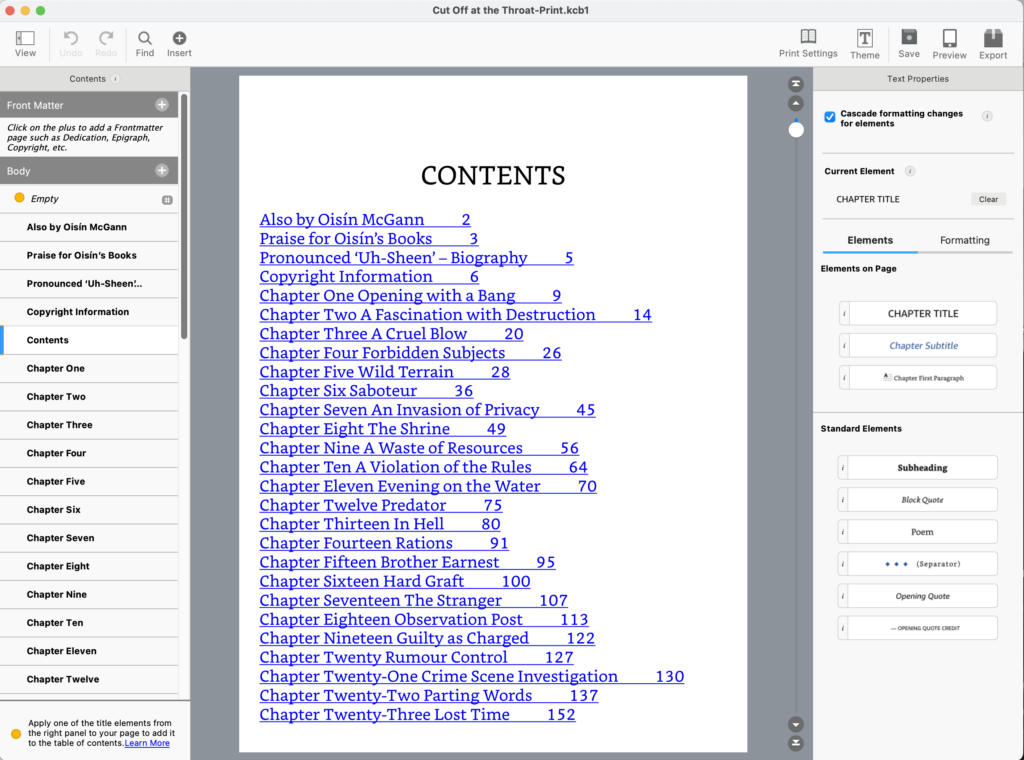
The ‘cover’ for the book isn’t part of the main ebook file and its layout does not change. It’s actually uploaded as a separate jpeg file, so pay attention to the instructions about the dimensions for the file. I used the painting app, Krita, for the artwork and Affinity Publisher to create the finished file, but you can do it in whatever image app you’re familiar with, and I started setting up the cover for the paperback as well, so that both versions would look the same. The paperback cover is more complicated however, and you don’t have to do that for the ebook.
One thing you need to think about is how your book is going to be tagged, so think of some keywords and genres/categories ahead of time. Have these noted down separately, don’t just bang them in on the form when you get to that part and move on, because you’re going to have to do this again for the paperback, and later on for the Nielsen and Bowkers forms.
The KDP site does a good job of walking you through the whole publishing process, whether it’s ebook or print, with everything broken into manageable steps, but I still found myself having to hunt down tips on different sections of it, and again, there are plenty of videos on YouTube that will talk you through it.
You can provide your own ISBN (International Standard Book Number), or the app can generate a free reference number for you. This is an ASIN (Amazon Standard Identification Number), and only works within Amazon’s system. I was only going to use Amazon for the ebook, so there was no point paying for one. I’ll talk about ISBNs further down.
Once you’ve uploaded the book and cover, you then have to choose your pricing and distribution options, which are just boxes to be filled in. If you decide to use Amazon to exclusively distribute your ebook, you can choose the 70% royalty rate, the thought of which would cause your average trad-published author to giggle hysterically. I figured that there wasn’t a wider ebook distribution than Amazon, so I took it, but you might feel differently.
And then you’re done. Just click and you’re published. There’s a waiting period while the book goes through some kind of vetting process (I’m not sure what it’s vetted for), and within a day or so, it’s up on Amazon’s website.
Making the Paperback Interior
There’s a fair bit more work in producing the paperback, as you have to create a print-ready PDF, and if it doesn’t fit the app’s standards, it won’t let you move on to the next step, which is a good safeguard. I made a mistake here, because most of the help videos I watched advised setting it up for print in MS Word and creating your PDF straight from there. It will certainly allow you to create a file that works, but anyone who has ever used Word – or in my case, LibreOffice – will know that when it comes to doing page layouts, it’s like making a scrapbook while wearing boxing gloves.
Don’t get me wrong; you can produce a perfectly readable Word file that can be printed as a book, but if you have the skills to use a more professional programme, then do it. It’ll take more time, but you’ll waste less of that time faffing around and fixing fewer issues afterward, and you’ll have a more professional looking book.
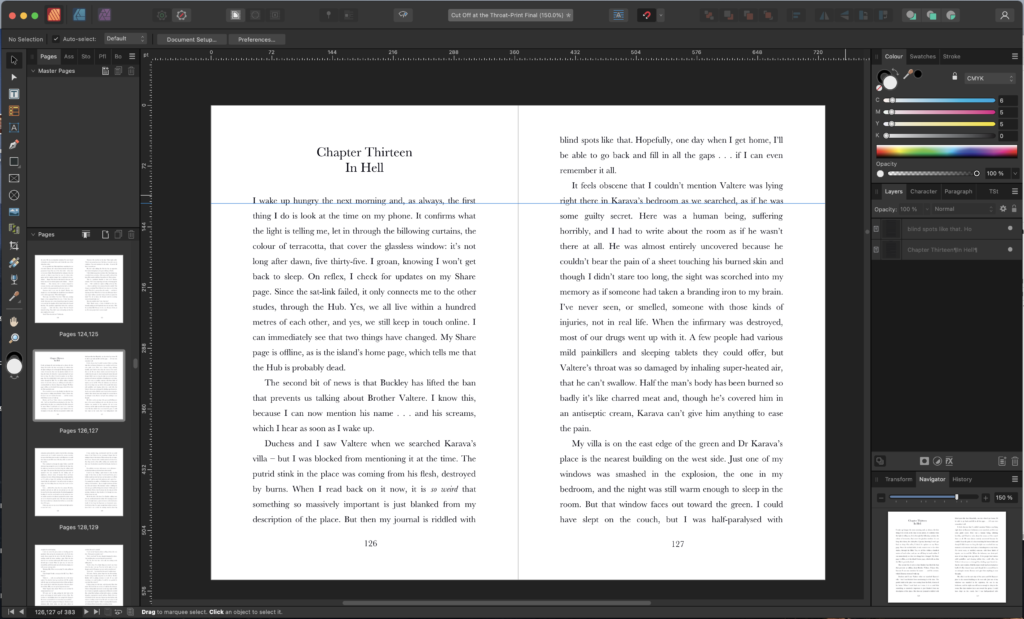
I write in LibreOffice and I set up the first print file there. It was so much hassle then, trying to fix things in the layout app I use, Affinity Publisher, I realized I should have brought the text in there to begin with. Back when I did a lot more graphic design, I used Quark Xpress and then Adobe InDesign. If you don’t have experience with using apps like that, it can get very technical, though the results are worth it. Affinity Publisher is a professional level app that does the same job for a fraction of the price.
Look at a published book you can use as a model for yours and take note of where things are and how they’re laid out. You’ll have a title page, copyright information and a biography. You might also have a dedication, acknowledgements, quotes of reviews, a list of the author’s other books, an introduction or a contents page or even a map or diagrams. The title page needs to be on a righthand page, facing the inside cover. The start of your first chapter would usually be on the right too, facing a blank page.
What size is your book going to be? The KDP platform gives you a range of dimensions to choose from, but to get a sense of it, it’s best to find a book the size you like and measure it. What font are you going to use? What size do you want your text? What leading do you want? This is the vertical spacing between the lines. Don’t have it too crammed, but don’t waste space either. Extra space means extra pages, which means extra cost.
There will be a gap at the top of each chapter for the chapter heading. Be careful it doesn’t knock off the spacing in your text. The rows of text on both pages should line up with each other. It helps to have the chapter heading in a separate text box, so the larger font doesn’t mess up your leading. The text in a novel is justified, stretching to both margins, and this can screw up the tracking – the horizontal spacing – as the words try and fill each line. It can cause big gaps or s t r e t c h e d – l o o k i ng – words.
The ability to adjust all of these things is where a good layout programme really earns its keep. Doing it yourself means you can change the wording here and there for the most awkwardly spaced lines, something a designer can’t do. You’ll need page numbers to go at the bottom of the page, in the middle or at the outer corner. Bear in mind that if you’re doing a contents page, changes to the text could change what page a chapter starts on. If you want to put the title or chapter title in a header at the top, make sure that’s not interfering with your main text either.
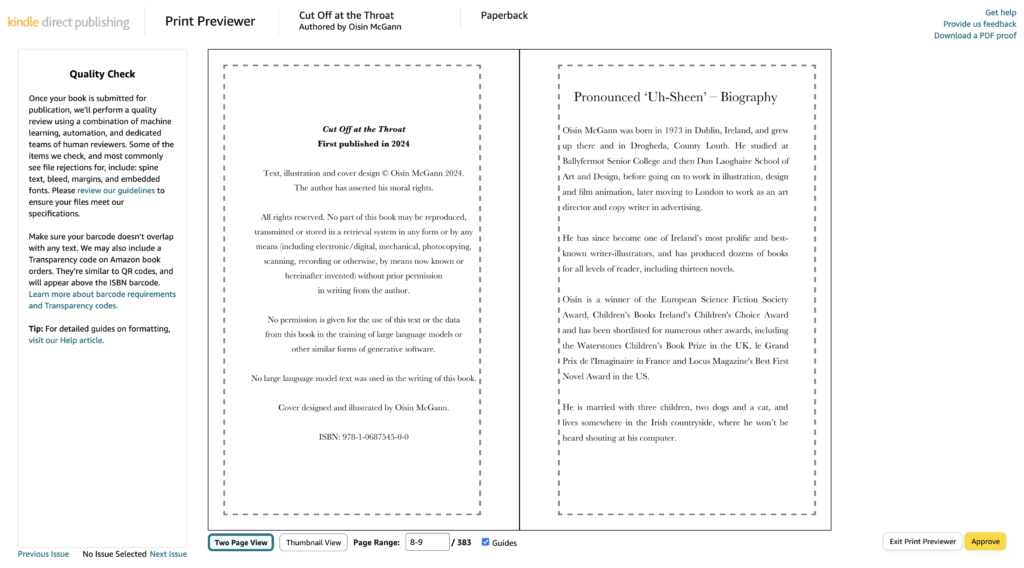
For the print file, you have to allow for a gutter – the space you lose on the inside edge of each page because of the binding. One of the things I found really awkward was resizing this later on, because the KDP site wouldn’t let me move on until I did the margins the way it wanted. The next time I set up a book, I made sure I had those measurements right the first time, and in an Affinity file, where it would be more straightforward to change.
It’s important to print out some sample pages and see if they match what you’re aiming for, checking the size, spacing and margins. Seeing them onscreen doesn’t give you a clear enough idea how they’ll come out. Compare your sample pages with other books of the same type.
When I was laying everything out, I worked in spreads as you can see on the Affinity screenshot above, because you got a better feel for how it looked, but for the final PDF, it needs to be laid out in single pages, which you can do just before you export.
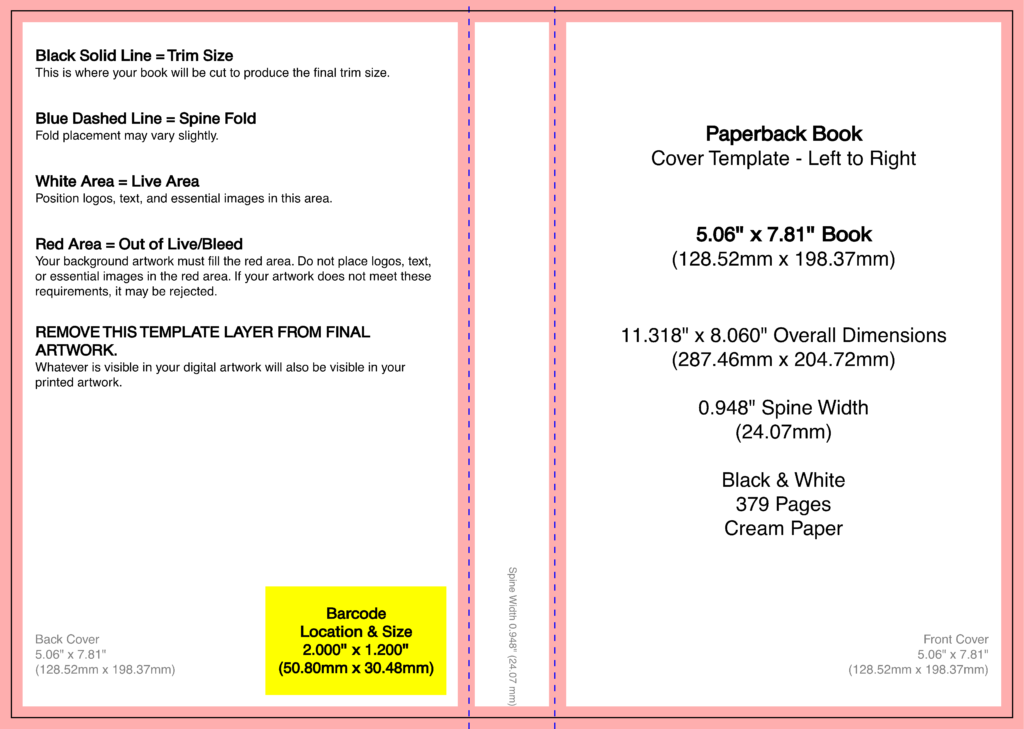
Making the Paperback Cover
Even if you don’t want an image that stretches from the front cover to the back, your design layout will have to, so you might as well use the space. I definitely wanted it. I could do a whole post on how to design a book cover (maybe I will some day), but the main points are to make it clear, distinct, compelling, appropriate to the genre and it should say something about the story. The simpler the layout, the better.
The front is the sizzle, but the back is the sausage – it’s all business. You need a blurb (keep it under 200 words, and less is better), your publisher’s logo if you’re going to have one, credit for the cover artist or designer and the ISBN barcode. I’ll get back to that in a bit. The KDP site has a good page for setting up the dimensions and margins. Crucially, it also allows you to calculate the width of the spine of your book based on the paper and the number of pages. You need these dimensions before you do the finished design, as it affects the width of the file, the full width being the combination of the back cover, spine and front cover.
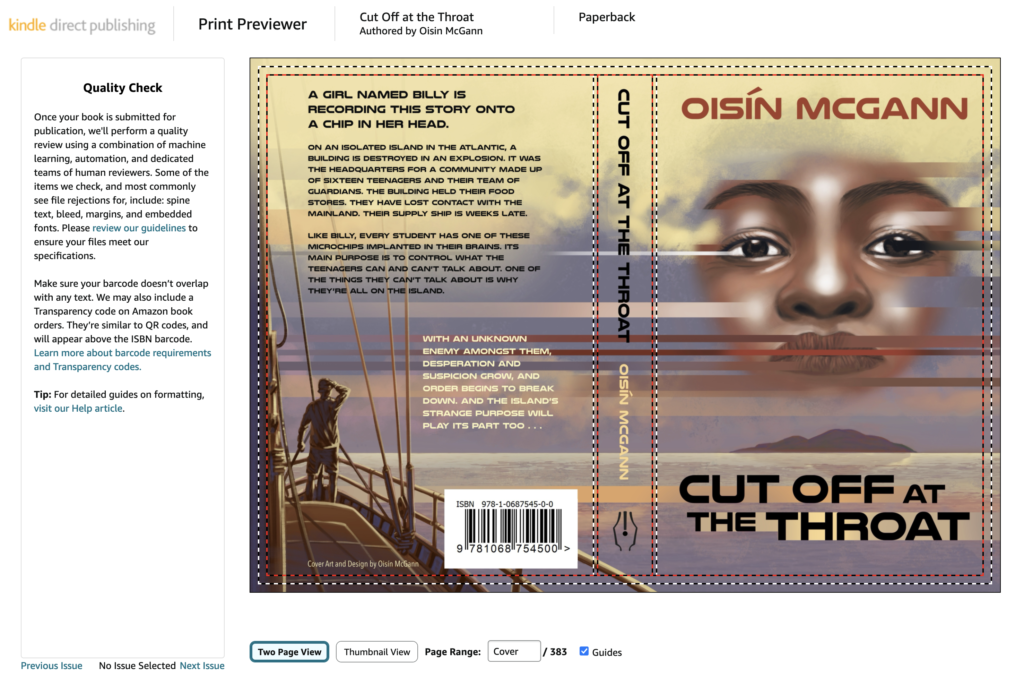
This also means that you have to have the PDF of your internal pages finished and uploaded, because it determines the number of pages in your book, which dictates the width of the spine. Once you’ve established the format and number of pages for the book, the app allows you to download a very clear layout template the exact size needed for your cover, at the right resolution, including the bleed you need all round the edges, so you can use it as the basis for your cover file.
All your design elements have to fit within the cover layout’s margins or the app will nag you to fix it. However, the background and/or cover image have to bleed off the page. The bleed (usually 3mm) is the extra bit of space that allows for some error when the final book is being trimmed down to size.
There is a cover creator app that can help you make one from scratch, but I didn’t use it.
The Distribution Networks
Once the book creation stuff is done, and your text and cover PDFs have both been accepted, like the ebook, you have to set the pricing and distribution options. There’s a section labelled ‘Expanded Distribution’ that wouldn’t work for me, but it’s just as well because using it seems to reduce your royalties from 60% to 40%.
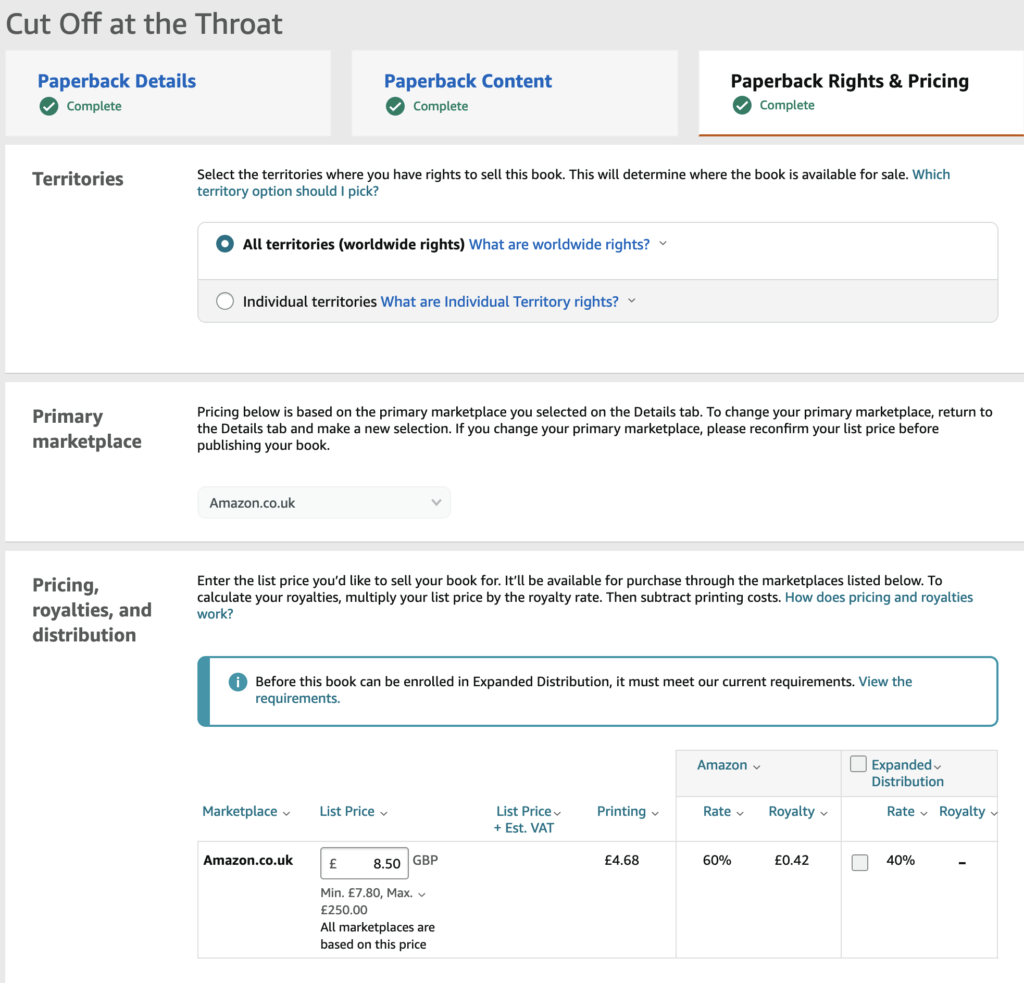
I was planning to use IngramSpark (operated by Lightning Source) as well as Amazon anyway, which enables distribution through physical shops as well as online (though the fact they can stock it doesn’t mean they will), so it didn’t seem like a big issue. According to one how-to video I watched, it’s best that you use your ISBN on KDP first because if it’s already being used by another distributor, you won’t get the higher royalty rate on Amazon.
To be clear, it’s free to set up and sell your book on either Amazon or IngramSpark. Once there, people can order the ebook or the paperback by print-on-demand, which is excellent. The two things you do have to pay for, are the ISBN and its barcode.
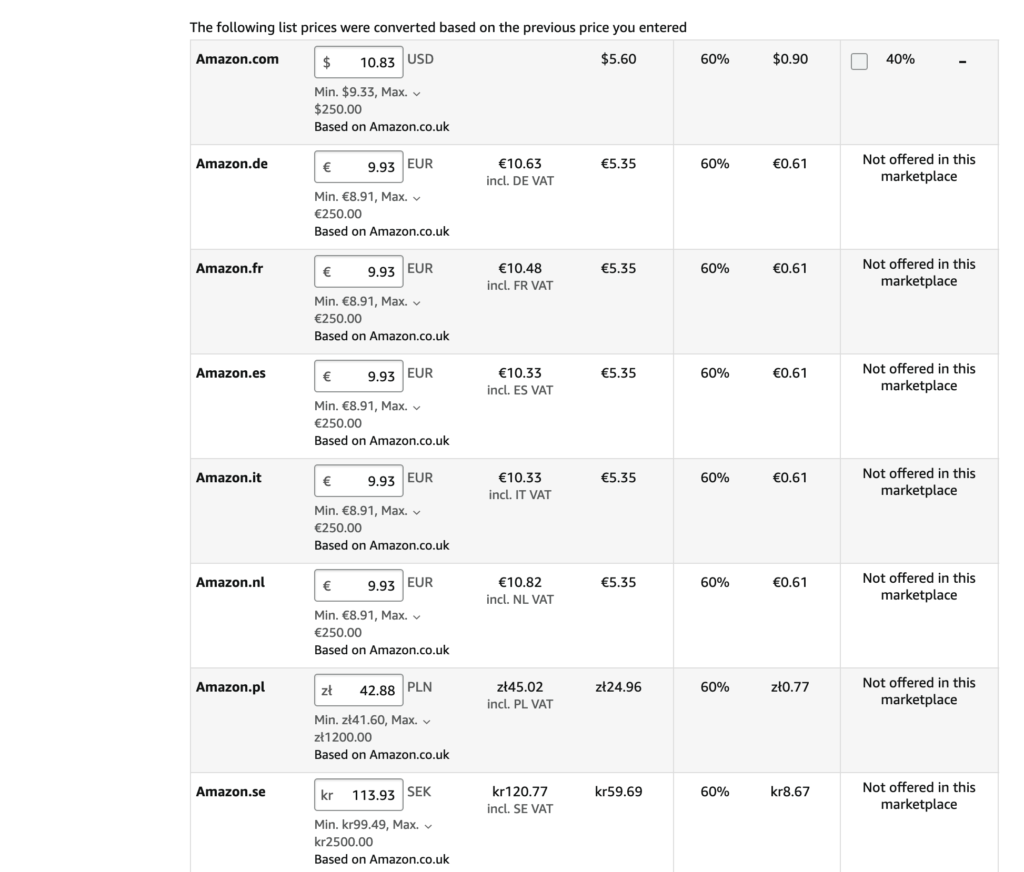
And for a print book, you have to have the ISBN. You can buy one through Amazon, but I figured they’d just charge a mark-up on it and I wanted to suss out the different systems anyway.
In Ireland and the UK, we buy ISBNs and register them through Nielsen. Here’s how they’re described on their site: ‘The International Standard Book Number (ISBN) is a unique product identifier for books and related material. Whilst it is not a legal requirement to allocate ISBNs to your books, it is used by publishers, booksellers and libraries for ordering, listing and stock control purposes. It enables them to identify a particular publisher and allows the publisher to identify a specific edition of a specific title in a specific format within their output. Systems used by publishers, booksellers and libraries all rely on the ISBN to identify books ensuring they select and stock the correct title and edition.’
The first thing you have to do is create an account, of course. Once that’s set up, you can buy your ISBN. At the time of writing, it was £93 for one, £174 for ten, £387 for a hundred or £994 for a thousand. However, you’re still not done paying because then you have to convert the number into a barcode for the back of your book. There again, the prices scale (slightly, see the accompanying image), but you start at £15 for one. To me, this seems like they’re selling you a car and then charging you extra for the wheels, but so be it, this is the price of entry. Now you have the barcode for your back cover.

Then you have to register the details of your book to set up the metadata (information) you want attached to the ISBN, which is the whole point of having it. This is done on a separate Nielsen site called Title Editor. Yes, you have to create an account on that too. It has the feel of a very old site, no doubt the type that’s running on an outdated version of Windows maintained by some ancient nerd who originally set it up and now is single-handedly keeping the entire UK book industry from collapsing. I use Firefox as my browser and certain options wouldn’t show up for me on the menu, so I had to switch to Safari. Users of Windows might not have any problems with it. The form below is incomplete because this was one of the screenshots I took before trying to reload it again. I had to contact customer support for help on this, and to be fair to them, they responded quickly and were keen to help.
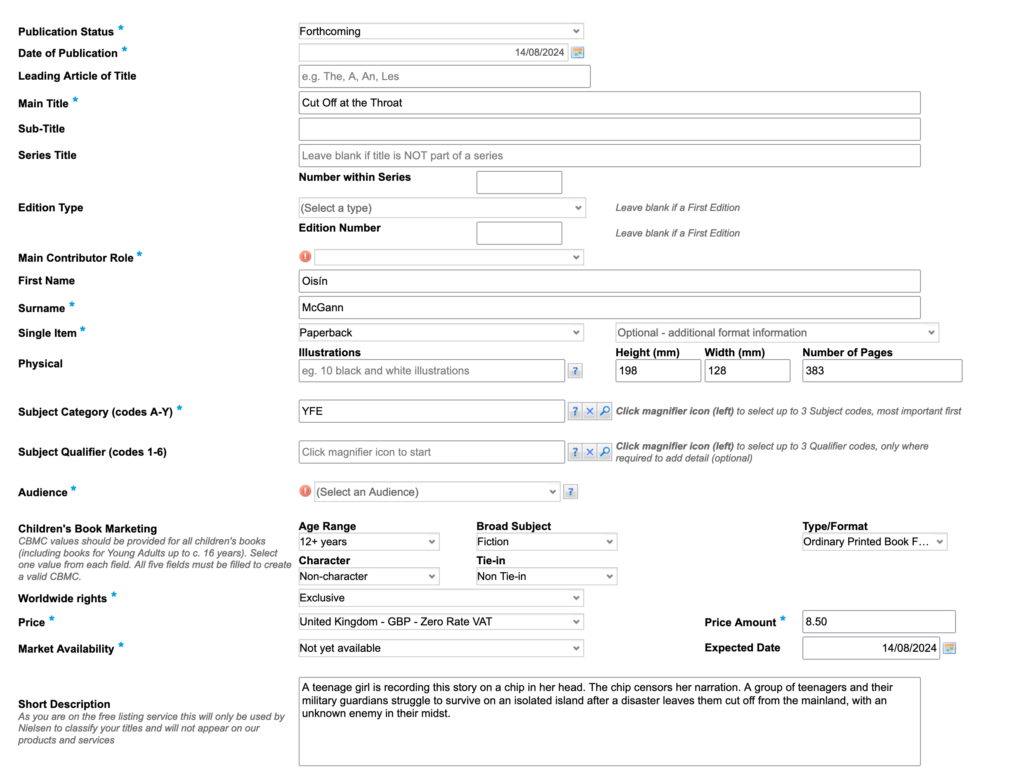
Again, as you have should have done when you were filling out the Amazon forms, hold on to the information you type into those boxes, because you’re still not done. Having registered the book with Nielsen for Europe, you now have to do the same thing with Bowkers in the United States. Yes, ‘Bowkers’ is their real name. Having gone through this once, it’ll feel easier a second time, and every book you register with either organization after this will be more straightforward.
Now the paperback was ready to publish on Amazon, and publish it I did.
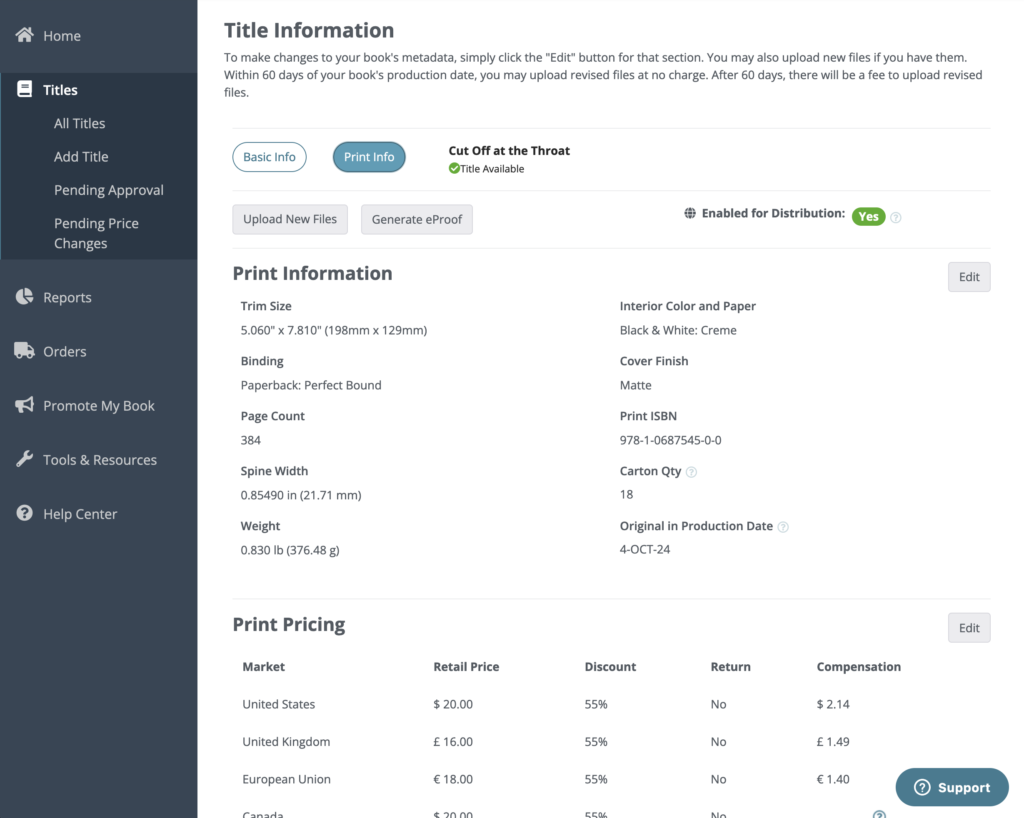
After it became available on Amazon, I went to IngramSpark, which is another self-publishing platform, one that has its own massive network that can distribute to bookshops.
IngramSpark’s process for creating the print-on-demand files is simpler but cruder, and not as helpful, but with everything already set up for Amazon, it all went much smoother. The cost per book also seems to be higher, although their pricing structure is a bit different – they have to account for the possibility of a proper retailer’s cut – which forces you to price the books higher than on Amazon.
You also have to say if you want to do sale-or-return, which means bookshops could send copies back if they don’t sell. I didn’t want to do that, but it does mean they’re much less likely to stock it unless it’s specifically ordered by someone.
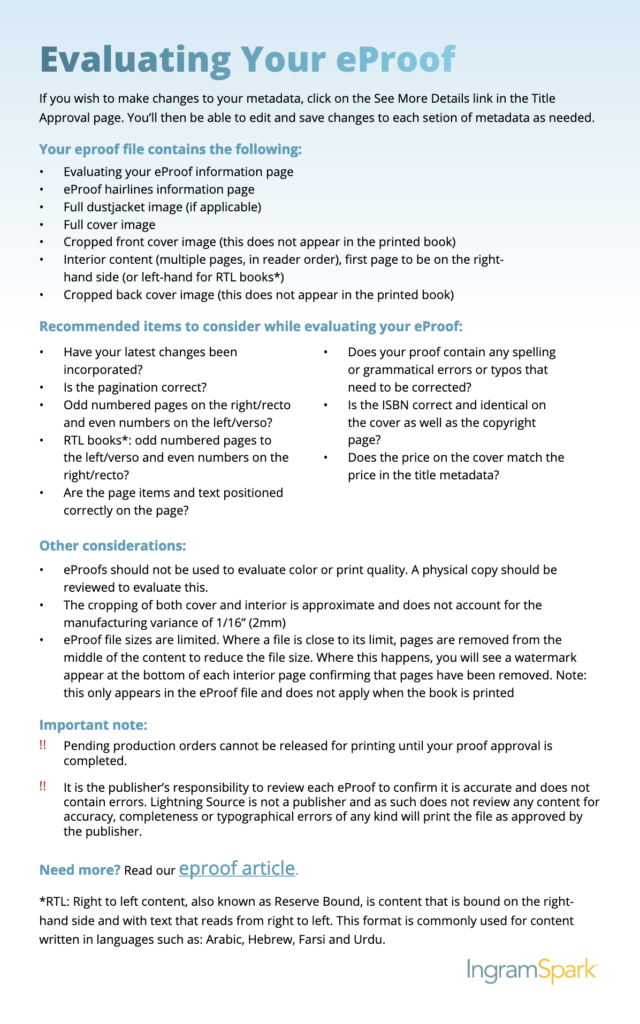
It was only when I tried to get a proof done that I found out that Amazon.co.uk wouldn’t deliver to Ireland. I asked customer support, who confirmed it just wasn’t available to my address. But I’ve since found that YES, DELIVERY IS AVAILABLE from the UK site, so I don’t know what’s going on there, and whether the long wait was just part of the system. Probably another thing that Brexit has screwed up. From what I’m hearing, that situation could get even worse next year.
By the way, if you do want copies of your book, make sure you order through your KDP account so you get them at cost, not through your normal retail account, where you’ll be charged the full price.
Some things you just can’t judge until you can see it in print, which is why you’d normally do proofs for any serious project – test prints. You can order proof copies of your book, which I assume are cheaper than normal ones, but I didn’t really see the point; they come with ‘PROOF’ printed across the cover and I figured it would be better to have a proper book, even if it was a flawed one. I ordered the first copy from Amazon.com, because it was the first place it was available, then it took a few more weeks to be able to get it from Amazon.co.uk.
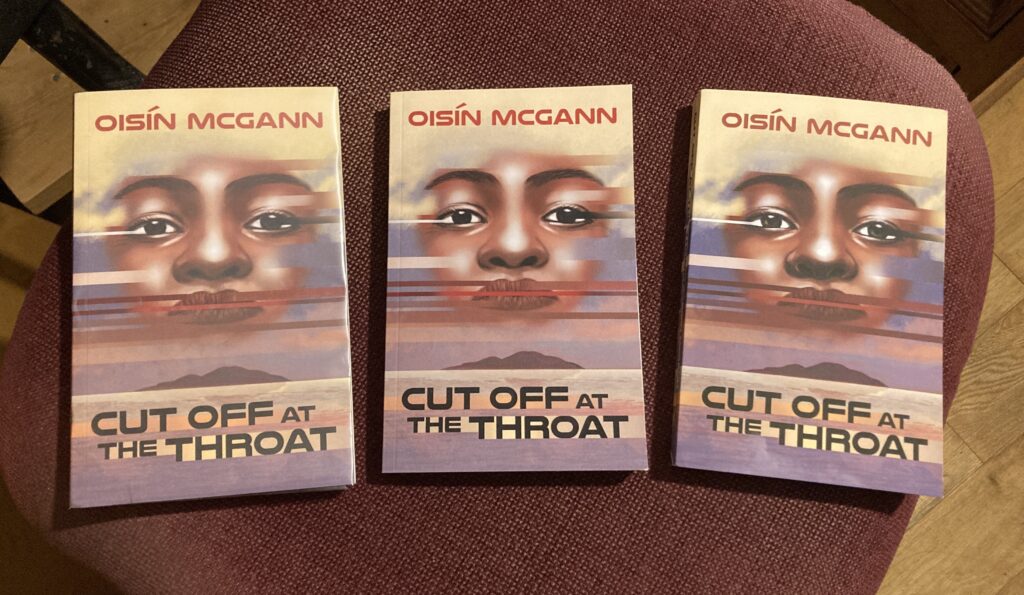
As it turned out, the books looked okay, but there were a couple of mistakes in the text and I wasn’t quite happy with the cover. The colours looked a bit washed out, particularly on the UK copy, and I wanted to tighten up some of the details in the face. Once I’d made the changes in the files, it was easy enough to update them in both the KDP and IngramSpark accounts, and then I ordered a third copy from Ingram, which looked better. You can see the three different versions in the photo; from left to right: the Amazon US, UK and Ingram copies. The copy on the left, the US KDP one, has a plastic cover because I have it in my events case now, so the difference in colour between it and the UK one is hard to see, but it’s very noticeable in real life. I’m much happier with the updated version, and I do love having this degree of control over the book.
I was less happy with Ingram’s price – I’d really like a competitive alternative to Amazon. Here’s how they compared for author copies:
KDP US
Author Price: 5.32 – Handling/Shipping: 4.63 – Exchange Rate Fee: 0.17 – Total: €10.12
KDP UK
Author Price: 5.65 – Handling/Shipping: 4.46 – Exchange Rate Fee: 0.18 – Total: €10.29
IngramSpark
Author Price: 6.48 – Handling: 1.99 – Shipping: 6.14 – Total: €14.61
As you can see, there wasn’t a huge difference between sourcing the book from KDP in the US and the UK, which seems odd. Another Brexit Benefit, I wonder? I had thought the Ingram copy would be coming from the States, especially for that price, but it was actually printed in the UK.
Overall, I was very happy with the print quality on all three books – in fact, it was better than some books I’ve had produced by mainstream publishers.
Letting the World Know It’s There
I created an author page on Amazon, which I really should have had for a while, having had books on the site since I started publishing. I discovered that there were already TWO other author pages with my books on them, and neither of them had been created by any of my publishers, as far as I could see. Because those books were already claimed by those pages, I couldn’t add them to mine. When I contacted customer support about this, I was surprised to find they were very on the ball. I had a KDP account now, so my identity was solidly established. Not only did they confirm my authorship of those books, they sought out ALL of the books of mine they could find on Amazon and put them on my page for me, and they had it done within a few days. This is Amazon we’re talking about . . . I’m still amazed I even got any kind of response at all.
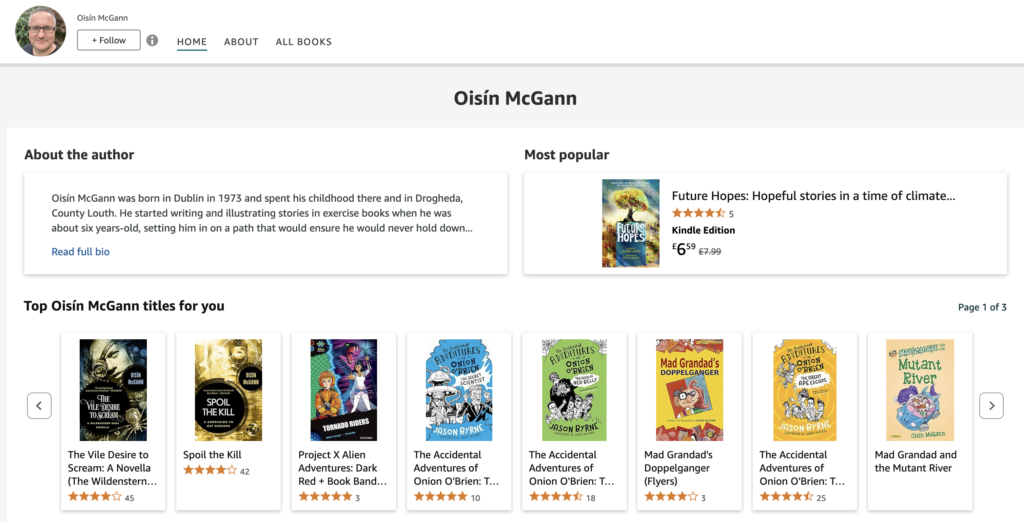
Once you’re published, the site gives you options to promote your ebook at a reduced price or for free for a limited time, which is handy for promotions. It also, naturally, starts pitching you extra promotions you can do for additional fees. I didn’t have much money to spend on this book and I was wary of how useful these would be for what I could pay, so I haven’t yet bothered with any of them. The same goes for IngramSpark.
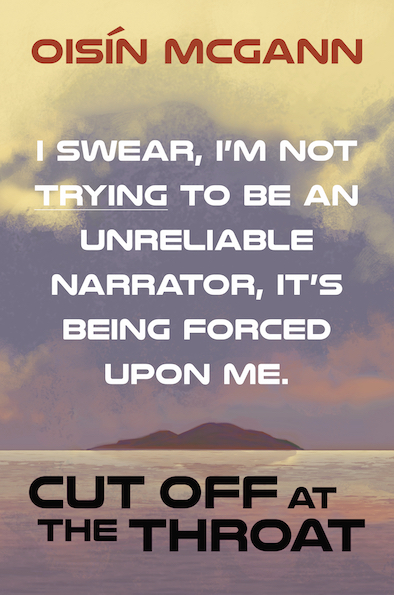
One of the real challenges of being a children’s and YA author has always been the lack of contact you have online with your readers. I’ve never really chased social media trends, and while I know some authors are really good at interacting online, I don’t seek out online contact with my younger readers. I’m not on Instagram any more, I’ve never been on SnapChat or TikTok and I’m sure I’ll fail to follow the crowd to whatever the kids are into next. I do a LOT of live events in libraries, schools and festivals, but even there, teenagers can be hard to reach – it’s something the publishing industry has never managed to do consistently – and what audience I have online is mostly made up of adults broken up over my various areas of interest, only some of whom are going to be interested in my books. Fortunately, most ‘young adult’ books are actually bought by older adults so there was some hope. I did start a month-long campaign on Bluesky, Twitter and Facebook. Using the front cover image as a background, I started posting a different quote from the book each day.
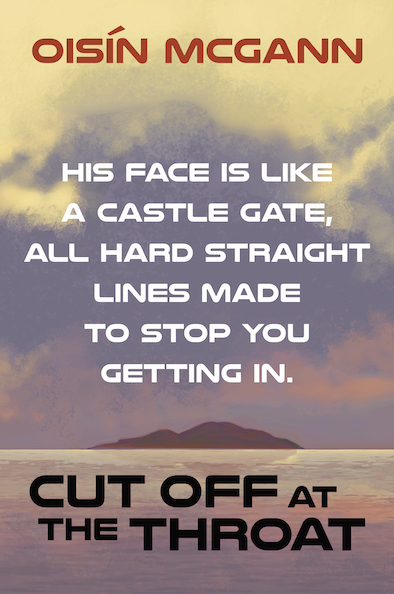
People will get tired of any technique you push too often, so I also did the reduced price thing and then, as I came to the end of that month, the free ebook offer. Amazon rankings change several times a day, and though it’s hard to make any headway in the overall charts, small numbers can shift you around in the sub-genres quite a bit. That’s part of the importance of getting those keywords and categories right when you’re filling out the boxes on those forms.
Remember those promotional ebooks I mentioned way back at the start of this excessively long blog? Well, when I started pushing Cut Off at the Throat on Amazon, I found two of them sitting there in the top ten in their respective categories in free ebooks. This was back in August and Spoil the Kill and The Vile Desire to Scream are still there at the time of writing. It’s possible they were there for months before that – or longer. They’re available for free, no royalties, so I hadn’t checked on them for years and the US publisher, Open Road, never mentioned them.
Anyway, Cut Off at the Throat got some early sales, which was enough movement for it to become a ‘Hot Release’ in some of its sub-genres on both the UK and US sites, as it got into the top ten in categories like ‘Teen and YA Fantasy Mystery’, ‘Children’s Dystopian Sci-Fi’ and ‘Teen and YA Action and Adventure Sci-Fi’. Over the month that I pushed the book, I sold less than a hundred copies, plus whatever reads I ended up getting on Kindle Unlimited (which I have mixed feelings about), but that’s what you might hope for from a very successful single-night launch in the real world, which would probably take more work and would be a bigger risk. And that wasn’t a bad start, considering I had no publisher support and haven’t released a real young adult book in several years. There can be a really fast turnover of audience in this market.
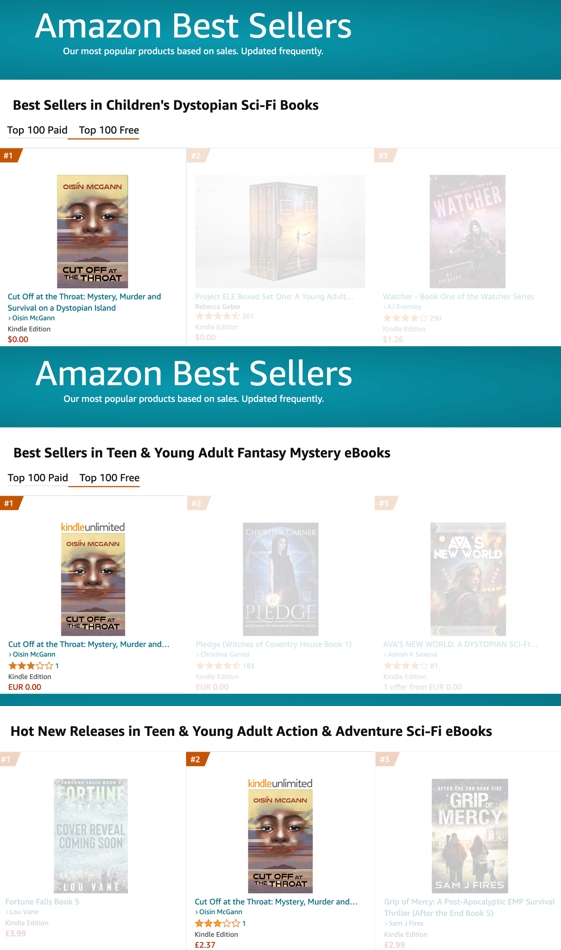
It might have taken very small numbers to do it, but the rankings gave me something else to talk about online and I think the traffic helped make the book more visible in searches (it also makes me very cynical about anyone who refers to having an ‘Amazon Bestseller’). Having more reviews would make an even bigger difference, so I’m still keeping my fingers crossed on that one. In the meantime, it’s the book I’ll talk about when I’m doing events for teenagers, and it feels good to have a new book out that’s really mine; all the books and short stories I’ve done in recent years have been commissioned in one way or another.
The whole thing has been an interesting experiment, and despite the challenges (and there were many), I’ve really enjoyed the process. This book has had a long, bumpy ride and only made it through because it was as stubborn as hell. The next one I’ve done however, was a LOT more straightforward. It’s a Halloween book that’s already available, but I won’t really start pushing it until next year, and I’ll be marketing it in a different way.
This has been one of the longest blogs I’ve ever done, so I really hope people find it interesting, but especially that they find it useful. The world of publishing is changing, and though the range of tools available to book creators is amazing, it can also be bewildering, and I include myself in that. Hopefully this has been helpful to some of you – and if so, please buy the book! I’ve written a lot about publishing over the years, so if you like this piece, do check out my other posts too. Thanks for reading.
You can find Cut Off at the Throat here for the United Kingdom.
